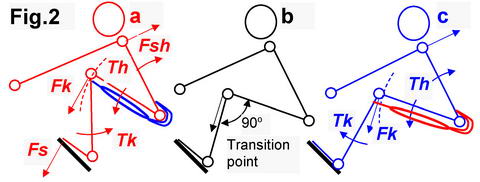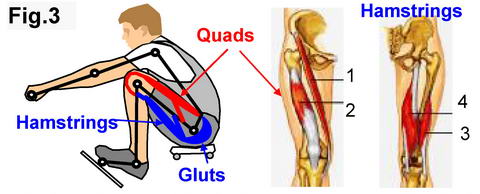Using legs and trunk during the drive

Q.: Why having “shins vertical” is a
desired starting point at the catch? Is it easy to observe and coach? Is it a biomechanical
advantage?
A.: With proper sequencing of the body segments, the drive begins with knee extension using the quadriceps, which creates a torque Tk around the knee joint (Fig.1). The shins perform a rotational movement with the centre of the knee, so the torque Tk creates a force vector Fa at the ankle joint normally directed to a circle, perpendicularly to the radius (shins). This force works in the same direction through the feet (at passively stretched calf muscles, RBN 2016/06) and applied through the toes to the stretcher as force Fs. The latter creates equal and oppositely directed reaction force Fr, which transferred to the rower’s centre of mass CM and accelerates it.

If shins are vertical at the catch (Fig.1,a),
then the forces Fa and Fs are directed horizontally, which
is the only productive direction in rowing. The stretcher force Fs
is transferred through the boat-rigger-oarlock to the oar sleeve and creates
propulsive force at the blade (“catch through the stretcher”, RBN 2006/09). The
reaction Fr force accelerates the rower’s mass forward.
If shins are over the vertical at the catch
(“over-compression”, Fig.1,b), then forces Fa and Fs are directed downwards,
which pushes down the stretcher and stern of the boat, and decreases the propulsive
force of the blade. The reaction force Fr is directed upwards in this case,
which lifts the rower’s mass up, but this is not a productive suspension: it
just transfers the rower’s weight from the seat onto the stretcher (RBN
2011/03), but decreases the forward acceleration of the rower’s CM.
The “shins vertical” position defines the maximal
leg compression at the catch, and sharper knee angles are unproductive.
Q.: Why is opening up with the
trunk at the catch a problem? When is the
best time to open the trunk?
A.: “Opening the trunk” means activation of the
glutes and hamstring muscles, which generates a torque Th around the hips
(Fig.2,a). This torque, transferred through the trunk creates forward force Fsh
at the shoulders, and transferred through the thighs pushing the knees down
with a force Fk. If this happens at knee angle less than 90o, it has
a number of negative effects:
1. The force Fk is transferred onto the stretcher as downwards force Fs, and creates a similar negative effect as over-compression of the knees at the catch (see above): it pushes the stretcher and stern down and lifts the rower’s mass up. The negative effects are summed up if over-compression is combined with early trunk opening.

2. At the catch, as the knee angle is usually sharper than 90o, the force Fk (perpendicular to the thigh) is directed above the shins and creates a negative torque Tk at the knee, which attempts to collapse it and must be overcome with the work of the quadriceps.

3. Both front and back thigh
muscles are biarticular and connected across two joints: hip and knee (Fig.3).
Parts of the quadriceps, Sartorius 1
and Rectus femoris 2 connect the shins
and the pelvis at the front. In the hamstrings, the long head of the Biceps femoris 3 and Semi-tendinosus 4 connect the shins and
pelvis at the back. An attempt to extend the knees and hips at the same time
may lead to a situation where the quads and hamstrings would work against each
other, which creates energy losses and decreased efficiency.
The combination of points 2 and 3 above, gives the
quads a really hard job, so they get tired quickly.
The best position for opening
the trunk is at the “transition point” (RBN 2008/07) – at a 90o knee
angle and with the handle location approximately on top of the stretcher
(Fig.2,b), or a bit later. After the transition point, the knee down force Fk
is directed below the shins and creates a positive torque Fk, which helps to extend
the knee (Fig.2,c). The means the quads and hamstring muscles work in a good and
productive collaboration on knee extension. Quads could be even relaxed after
the transition point to allow the bigger and more powerful hamstring muscles to
finalise the knee extension job. This phenomenon was experimentally confirmed in
the best rowers using EMG (RBN 2010/11).
Concluding, sequential coordination of the legs
and trunk is the most efficient technique. The “transition point” is the best
position to start using the trunk.
©2017 Dr. Valery Kleshnev www.biorow.com



